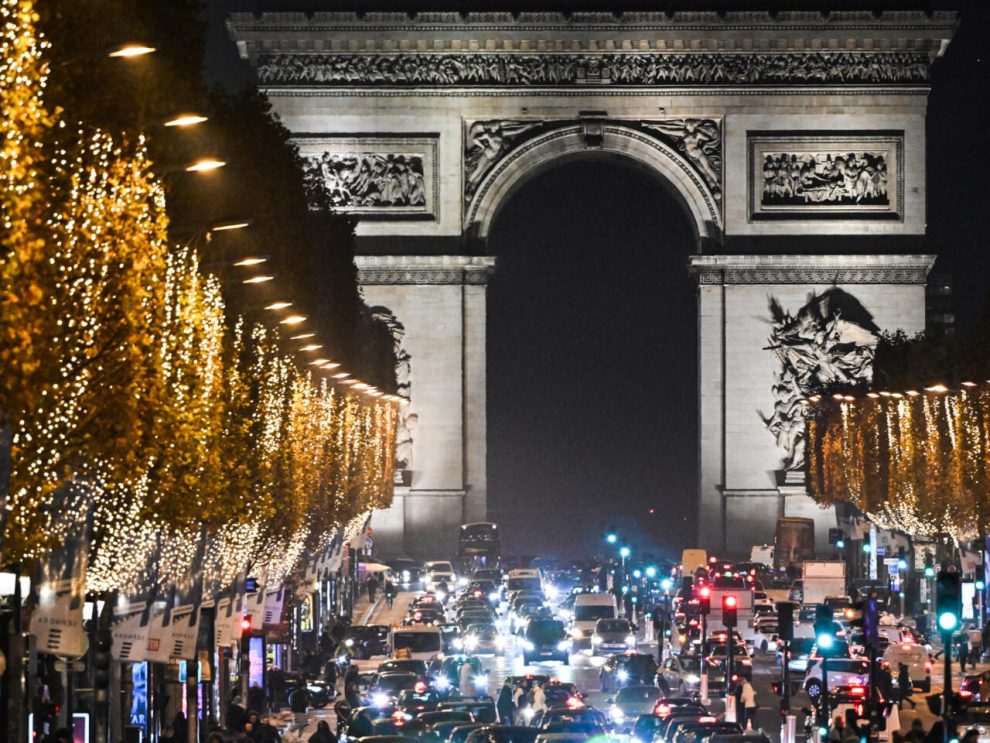Christmas illuminations in Paris are set to shine a little less brightly this year as local authorities are reducing decorations in a bid to save energy and keep down electricity costs.
On Paris’s most famous boulevard, the Champs-Élysées, the Christmas lights have undergone a subtle change this festive season. “I actually prefer them this year,” says one passer-by who prefers to remain anonymous. Behind him almost half a kilometre of fairy lights alternate between a steady golden glow and blue sparkles, meant to replicate illuminations on the Eiffel Tower.
In previous years, the Paris resident remembers a more modern lighting design with luminous hoops encircling the 400 trees that line the road on either side. The 2022 version is “more traditional, and more welcoming”, he says.
It is also more energy efficient. The Champs-Elysées committee, which governs the famous avenue, announced that illuminations would be “drastically limited” this year in light of soaring energy prices that have seen electricity costs more than double in France (even though regulated tariff increases for consumers are currently capped at 4%) and around the world.
In a bid to maintain one of the most well-known festive sights in the French capital – and avoid exorbitant costs – the 2022 illuminations feature millions of energy-saving LED lights that will be on display for six, rather than seven, weeks. With the exception of December 24 and 31, the lights will also be switched off two hours and fifteen minutes earlier than usual every evening at 11:45pm.
These small tweaks are expected to have a dramatic impact, with total electricity use forecast at 11,500 KWH – 44% less than in 2021. “Total consumption on the Champs-Élysées will be the same as two people living in a 50 metre square apartment,” said Marc-Antoine Jamet, chairman of the Champs-Élysées committee.
‘It’s still very joyful’
Multiple cities around France have made similar decisions in order to save energy this Christmas. Toulouse’s light display will be shortened by two weeks. Lyon will switch off illuminations earlier than usual every night. In Bordeaux, the mayor’s office said measures to reduce Christmas lights would cut their total energy bill to just €1,600 compared to €2,000 in 2021. And in Strasbourg, the famous Christmas market will have 20% fewer lights and an overall reduction in electricity consumption of 10%, the mayor’s office said.
In many cases, it is not just decorations that are being scaled back. Paris has cut down the number and size of its outdoor ice rinks and has even introduced an eco-friendly version in central shopping district Les Halles. Instead of a sheet of ice, which requires a large amount of energy to keep cold, skaters can glide across 200 metres of reusable, synthetic panels which use no water or electricity.
In the capital’s Christmas markets, opening hours have also been shortened to reduce electricity use. Even so, “there are a lot of people here. More than last year when the American tourists couldn’t travel [due to Covid-19 restrictions],” says Simoes, who is running a stall selling products made of cork in the Tuileries Gardens’ Christmas market for the second year running.
Despite evening temperatures in the minus, the market is lively with people who have come to browse stalls for souvenirs, warm up with hot food and drinks, and soak up the festive atmosphere.
This year stallholders are working in chalets with less decorative lights and no heating in order to save energy. “You have to adjust to it, but my stand has walls so it’s not too cold,” says Gaëlle, who is selling ornaments she has made. This is her fourth year at the market, and she doesn’t feel the energy-saving measures negatively affect the atmosphere, especially compared with two previous seasons impacted by Covid-19.
“Last year we were still wearing health masks, but this year it’s much more natural and pleasant. Having fewer lights doesn’t at all take away from the heart of the event. It’s still very joyful.”
A sombre backdrop
Indeed, festive illuminations around the capital may be muted this year but they still stand out against a darker-than-usual backdrop. Since September, the streets and skies of the City of Light have looked unusually sombre at nighttime as monuments, shops and offices have collectively dimmed the lights.
Like many other shops in Paris, stores on the Champs-Élysées have been asked to turn off illuminated signs, screens, and shop windows at 10pm – almost two hours before the Christmas lights are switched off.
Most monuments in the capital now also go dark at 10pm with the exception of the Eiffel Tower, which keeps its lights on until the last tourists leave at 11:45pm.
Alongside steps such as lowering the thermostat in swimming pools and public buildings, members of the public have largely been in favour of the energy-saving measures, which are environmentally friendly as well as being cost-effective.
With street lights (left on for safety) as their main competition, even the reduced number of Christmas illuminations in Paris can be effective. In the Tuileries Garden, Alessia and Eleni are spending the first evening of a holiday in Paris enjoying the “cosy” atmosphere at the Christmas market.
They have not noticed a lack of festive illuminations. “There are less decorations in other countries too, it’s something that we just have to accept in this period,” says Eleni, from Belgium. “I like to look at things in a positive way – in Paris they have still gone to a lot of effort. I feel like it’s festive.”































